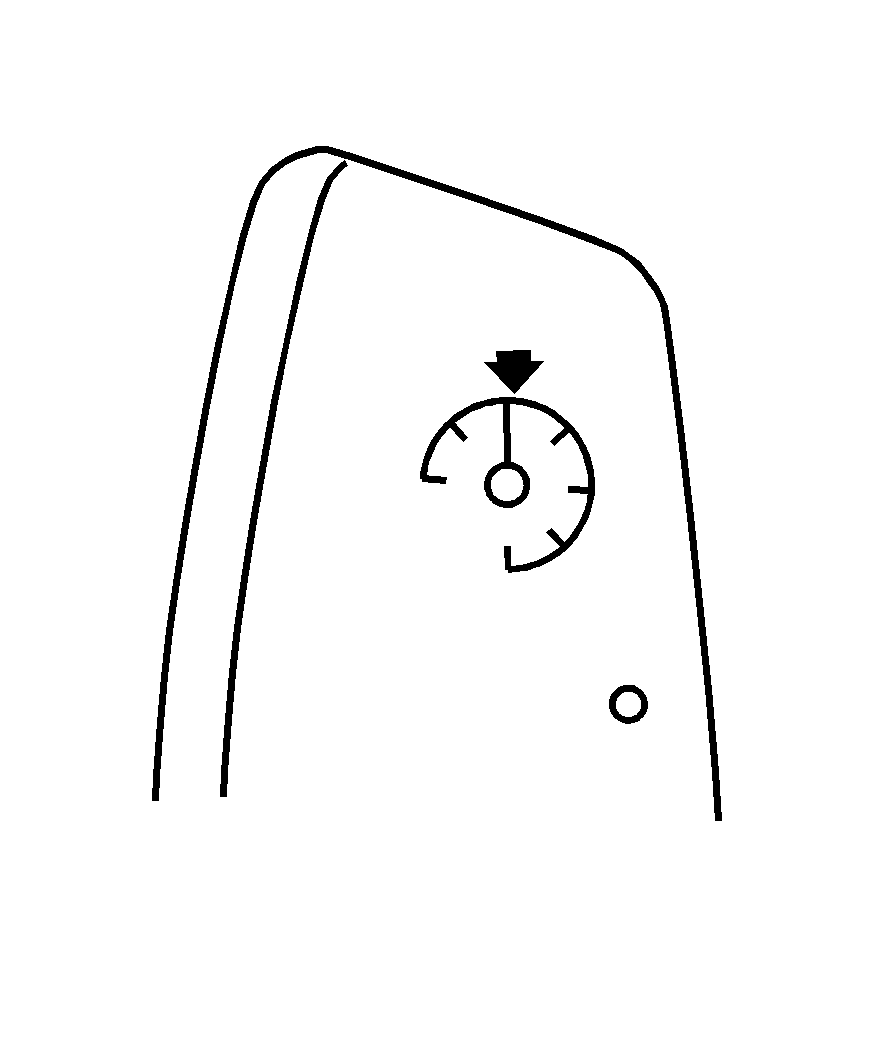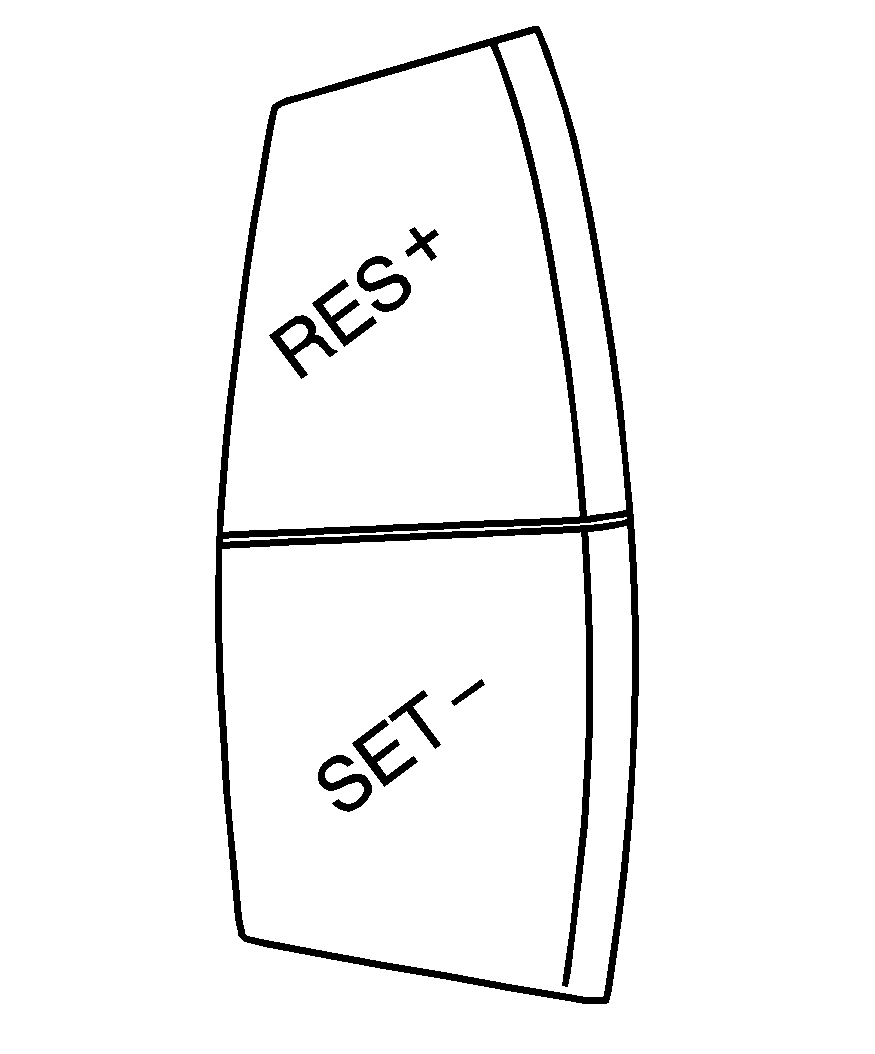

The buttons for the cruise control are located on the steering wheel.
(Cruise On/Off): Push this button to turn the system on and off.RES + (Resume/Accelerate): Push this button to make the vehicle resume a previously set speed or to accelerate when cruise is already active.
SET - (Set/Decelerate): Push this button to set the speed or to decrease the speed when cruise is already active.
With cruise control, a speed of about 25 mph (40 km/h) or more can be maintained without keeping your foot on the accelerator. This can really help on long trips. Cruise control does not work at speeds below about 25 mph (40 km/h).
When the brakes are applied, the cruise control turns off.
Caution: Cruise control can be dangerous where you cannot drive safely at a steady speed. So, do not use the cruise control on winding roads or in heavy traffic.
Cruise control can be dangerous on slippery roads. On such roads, fast changes in tire traction can cause excessive wheel slip, and you could lose control. Do not use cruise control on slippery roads.The cruise control will automatically disengage if the vehicle has the traction control system and begins to limit wheel spin. See Traction Control System (TCS) . When road conditions allow, the cruise control can be used again.
Setting Cruise Control
Caution: If you leave your cruise control on when you are not using cruise, you might hit a button and go into cruise when you do not want to. You could be startled and even lose control. Keep the cruise control switch off until you want to use cruise control.
- Press the cruise on/off button. The indicator light in the button will come on.
- Get up to the speed you want.
- Press the SET - button. The cruise symbol will display in the instrument panel cluster when the system is engaged.
- Take your foot off the accelerator pedal.
Resuming a Set Speed
Suppose you set your cruise control at a desired speed and then you apply the brake. This, of course, disengages the cruise control. The cruise symbol in the instrument panel cluster will go out, indicating cruise control is no longer engaged.
To return to your previously set speed, press the RES + button once you are going about 25 mph (40 km/h) or more.
You will go right back up to your chosen speed and stay there.
If you hold the RES + button, the vehicle will keep going faster until you release the button or apply the brake. So unless you want to go faster, do not hold the RES + button.
Increasing Speed While Using Cruise Control
There are two ways to go to a higher speed:
| • | Use the accelerator pedal to get to the higher speed. Press the SET - button, then release the button and the accelerator pedal. You'll now cruise at the higher speed. |
| • | Press the RES + button. Hold it there until you get up to the speed you want, and then release the button. To increase your speed in very small amounts, press the button briefly. Each time you do this, your vehicle will go about 1 mph (1.6 km/h) faster. |
Reducing Speed While Using Cruise Control
There are two ways to reduce your speed while using cruise control:
| • | Press the SET - button until you reach the lower speed you want, then release it. |
| • | To slow down in very small amounts, briefly press the SET - button. Each time you do this, you will go about 1 mph (1.6 km/h) slower. |
Passing Another Vehicle While Using Cruise Control
Use the accelerator pedal to increase the vehicle's speed. When you take your foot off the pedal, the vehicle will slow down to the cruise control speed you set earlier.
Using Cruise Control on Hills
How well the cruise control will work on hills depends upon the speed and load of the vehicle, and the steepness of the hills. When going up steep hills, you may have to step on the accelerator pedal to maintain the vehicle's speed. When going downhill, you may have to brake or shift to a lower gear to keep the vehicle's speed down. Of course, applying the brake takes the vehicle out of cruise control. Many drivers find this to be too much trouble and do not use cruise control on steep hills.
Ending Cruise Control
To end a cruise control session, step lightly on the brake pedal. Stepping on the brake will end the current cruise control session only. Press the cruise on/off button to turn off the system completely.
Erasing Speed Memory
When you turn off the cruise control or the ignition, your cruise control set speed memory is erased.
With cruise control, you can maintain a speed of about 25 mph (40 km/h) or more without keeping your foot on the accelerator. This can really help on long trips. Cruise control does not work at speeds below 25 mph (40 km/h).
Caution: Cruise control can be dangerous where you cannot drive safely at a steady speed. So, do not use the cruise control on winding roads or in heavy traffic.
Cruise control can be dangerous on slippery roads. On such roads, fast changes in tire traction can cause excessive wheel slip, and you could lose control. Do not use cruise control on slippery roads.Setting Cruise Control
Caution: If you leave your cruise control on when you are not using cruise, you might hit a button and go into cruise when you do not want to. You could be startled and even lose control. Keep the cruise control switch off until you want to use cruise control.


The cruise control buttons are located on the steering wheel.
(On/Off): Press this button to turn the cruise control system on and off.+RES (Resume): Press this part of the button to resume a set speed and to accelerate the speed.
-SET (Set): Press this part of the button to set a speed and to decrease the speed.
To set a speed do the following:
- Press the on/off button to turn cruise control on. The indicator light on the button will come on.
- Get to the speed you want.
- Press the -SET part of the control button and release it. The cruise symbol will display in the instrument panel cluster to show the system is engaged.
- Take your foot off the accelerator pedal.
When the brakes are applied, the cruise control shuts off.
If the vehicle is in cruise control and the Traction Control System (TCS) or Enhanced Traction System (ETS) begins to limit wheel spin, the cruise control will automatically disengage. See Traction Control System (TCS) and Enhanced Traction System (ETS) . When road conditions allow, the cruise control can be used again.
Resuming a Set Speed
Suppose you set your cruise control at a desired speed and then you apply the brake. This, of course, disengages the cruise control. The cruise symbol in the instrument panel cluster will also go out indicating cruise is no longer engaged. To return to your previously set speed, you do not need to go through the set process again. Once you're going about 25 mph (40 km/h) or more, you can press the +RES part of the button briefly.
This will take you back up to your previously chosen speed and stay there.
Increasing Speed While Using Cruise Control
There are two ways to go to a higher speed.
| • | Disengage the cruise control but do not turn it off. |
| • | If the cruise control system is already engaged, press the +RES part of the button. Hold it there until you get up to the speed you want, and then release the button. To increase your speed in very small amounts, press the +RES part of the button briefly and then release it. Each time you do this, your vehicle will go about 1 mph (1.6 km/h) faster. |
Reducing Speed While Using Cruise Control
If the cruise control system is already engaged,
| • | Push and hold the -SET part of the button until you reach the lower speed you want, then release it. |
| • | To slow down in very small amounts, push the -SET part of the button briefly. Each time you do this, you'll go about 1 mph (1.6 km/h) slower. |
Passing Another Vehicle While Using Cruise Control
Use the accelerator pedal to increase your speed. When you take your foot off the pedal, your vehicle will slow down to the cruise control speed you set earlier.
Using Cruise Control on Hills
How well your cruise control will work on hills depends upon your speed, load and the steepness of the hills. When going up steep hills, you may have to step on the accelerator pedal to maintain your speed. When going downhill, you may have to brake or shift to a lower gear to keep your speed down. Of course, applying the brake takes you out of cruise control. Many drivers find this to be too much trouble and don't use cruise control on steep hills.
Ending Cruise Control
There are two ways to disengage the cruise control:
| • | Step lightly on the brake pedal; when cruise control disengages, the cruise symbol in the instrument panel cluster will go out. |
| • | Press the on/off button, this will turn off the cruise control system. |
Erasing Speed Memory
When you turn off the cruise control or the ignition, your cruise control set speed memory is erased.
